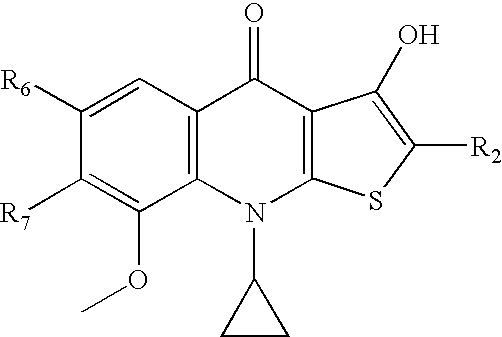Hydroxylthienoquinolones and related compounds as anti-infective agents
a technology of hydroxylthienoquinolones and related compounds, which is applied in the direction of antibacterial agents, drug compositions, biocides, etc., can solve the problems of increasing morbidity and mortality, increasing the risk of infection with these pathogens in elderly and immunocompromised patients, and few truly clinically acceptable antimicrobials produced, so as to achieve antibacterial, antiprotozoal, or selective
- Summary
- Abstract
- Description
- Claims
- Application Information
AI Technical Summary
Benefits of technology
Problems solved by technology
Method used
Image
Examples
example 1
Synthesis of 9-Cyclopropyl-6,7-Difluoro-3-Hydroxyl-8-Methoxy-4-oxo-4,9-dihydrothieno[2,3-b]quinoline-2-carbonitrile
[0219]
[0220]The title compound is prepared from ethyl 1-cyclopropyl-6,7-difluoro-2-mercapto-8-methoxy-4-oxo-1,4-dihydroquinoline-3-carboxylate (See US 2008071086, which is hereby incorporated by reference for its teachings regarding this and other compounds, see also, Hashimoto, et al., 2007) using a procedure analogous to that describing the preparation of 9-cyclopropyl-6,7-difluoro-3-hydroxyl-4-oxo-4,9-dihydrothieno[2,3-b]quinoline-2-carbonitrile. (Chiba, et al., JP 03-223289) The crude product is purified by recrystallization from DMF to give the title compound as a white solid. 1H NMR: δ 1.04 (m, 2H), 1.27 (m, 2H), 3.90 (m, 1H), 4.02 (d, J=1.5 Hz, 3H), 7.89 (dd, J=10.0 Hz, 8.5 Hz, 1H). 19F NMR: δ−145.0 (d, J=22.5 Hz, 1F), −138.9 (d, J=22.5 Hz, 1F). LCMS (APCI): m / z calcd for C16H10F2N2O3S ([M]+) 348. found 349 ([M+H]+).
example 2
Synthesis of (S)-1-((R)-1-Benzylpyrrolidin-3-yl)-N-(2-fluoroethyl)ethanamine
[0221]
[0222]Potassium iodide (0.71 g, 4.27 mmol) and 2-fluoroethyl 4-methylbenzenesulfonate (0.93 g, 4.27 mmol) (Kopka, et al., 2006) are added to a solution of (S)-1-((R)-1-benzylpyrrolidin-3-yl)ethanamine (0.83 g, 4.06 mmol) (Shroeder, et al., 1992) in DMF (10 mL). The reaction mixture is heated for 2 h at 100° C. and evaporated under reduced pressure. The residue is purified by column chromatography (chloroform-ethanol-triethylamine=30:1:1) to afford the desired product (0.51 g, 50%) as a brown oil. 1H NMR (CDCl3): δ 1.09 (d, J=6.3 Hz, 3H, methyl), 1.55 (m, 1H), 1.96 (m, 1H), 3.15-2.15 (m, 9H), 3.65 (s, 2H, —CH2Ph), 4.46 (m, 1H, —CHF), 4.61 (m, 1H, —CHF), 7.31 (m, 5H, ArH). 13C NMR (CDCl3): δ 18.1, 27.5, 43.8, 53.9, 56.7, 57.5, 60.4, 82.4, 84.6, 126.6, 128.1, 128.5, 139.0. LCMS: m / z calcd for C15H23FN2 ([M]+) 250. found 251 ([M+H]+).
example 3
Synthesis of 2-fluoro-N—((S)-1-((R)-pyrrolidin-3-yl)ethyl)ethanamine
[0223]
[0224]A solution of (S)-1-((R)-1-benzylpyrrolidin-3-yl)-N-(2-fluoroethyl)ethanamine (0.27 g, 1.08 mmol) and palladium hydroxide (0.27 g, 20 wt. % Pd on carbon, 50% wet) in ethanol (8.0 mL) is heated at 40° C. for 15 h under an atmosphere of hydrogen, and cooled to rt. The resulting mixture is filtered through a Büchner funnel on a layer of Celite washing with methanol. The filtrate is evaporated under reduced pressure to afford the title compound in quantitative yield (0.17 g). The residue obtained is used in the next reaction without further purification.
PUM
| Property | Measurement | Unit |
|---|---|---|
| flow rate | aaaaa | aaaaa |
| flow rate | aaaaa | aaaaa |
| concentrations | aaaaa | aaaaa |
Abstract
Description
Claims
Application Information
 Login to View More
Login to View More - R&D
- Intellectual Property
- Life Sciences
- Materials
- Tech Scout
- Unparalleled Data Quality
- Higher Quality Content
- 60% Fewer Hallucinations
Browse by: Latest US Patents, China's latest patents, Technical Efficacy Thesaurus, Application Domain, Technology Topic, Popular Technical Reports.
© 2025 PatSnap. All rights reserved.Legal|Privacy policy|Modern Slavery Act Transparency Statement|Sitemap|About US| Contact US: help@patsnap.com



